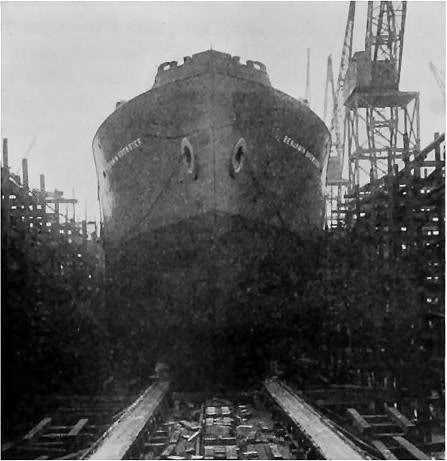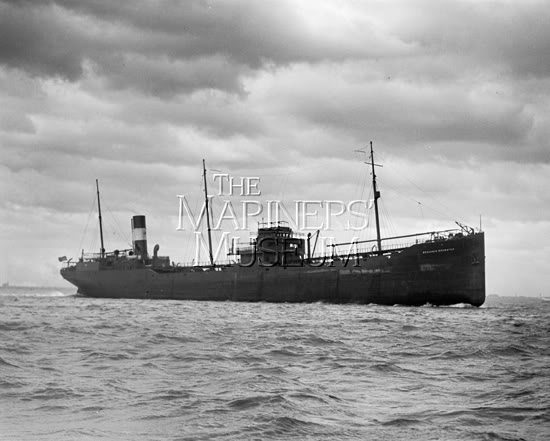Auke Visser's International Esso Tankers site | home
Benjamin Brewster - (1917-1942)
Launch of the "Benjamin Brewster" at the Harlan and Hollings Corporation shipyard, Wilmington, Delaware.
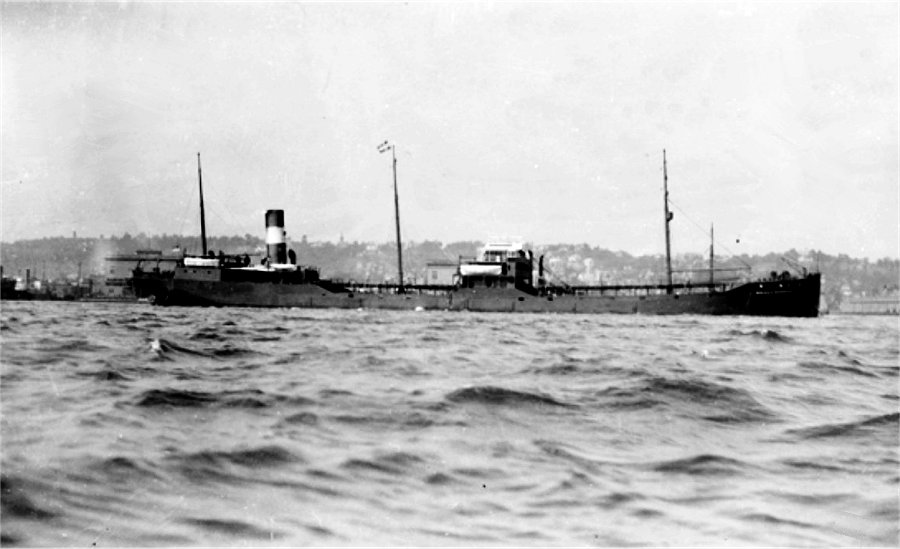
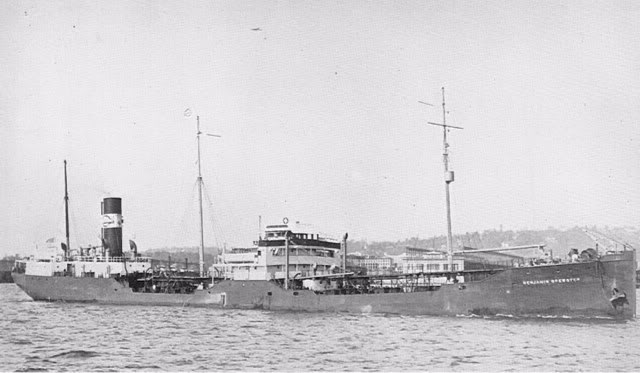
SS "Benjamin Brewster", was build in 1917.
"Benjamin Brewster".
( Photo by Edwin Levick )
From : Pacific Marine Review, VOL. XIV, No. 4, APRIL, 1917.
THE "BENJAMIN BREWSTER"
The steamship "Benjamin Brewster" was launched at the yards of the Harlan and Hollingsworth Corporation, Wilmington, Delaware, on Tuesday, February 20. She was built to the order of the Standard Oil Company of New Jersey to carry petroleum in bulk and is the first of four large tankers building at the Wilmington yard forthis corporation.
The vessel is 430 feet long over all, 412 feet betweenperpendiculars, 52 feet 1 inch moulded beam and 31 feet depth to the upper deck and has a long poop and short bridge and forecastle, the oflficers' accommodations being in houses on top of bridge and on poop, petty officers and crew being housed in the poop and forecastle.
The "Benjamin Brewster" is subdivided for carrying oil in bulk, having eighteen transverse bulkheads and one longitudinal bulkhead. She has 18 main oil tanks and ten Summer tanks. The pump room is amidships and a cofferdam it fitted at either end of the oil cargo space; also an intermediate cofferdam, with an additional cofferdam between the boiler room and the fuel oil bunker;four cofferdams in all. Under the forward dry cargo hold, a deep tank is fitted for ballast or fuel oil, if same is being used. The cross oil bunkers are all oil-tight riveted in case they are to be used for fuel oil. Double bottoms are fitted under engine and boiler rooms. The "Brewster" is built on the Isherwood longitudinal system.
This vessel will carry 8,130 tons deadweight on an extreme draft of 24 feet 8 inches, the gross measurement tonnage being 5,605 and the net 3,420 tons. She is propelled by triple expansion engines, having cylinders 27, 45 and 74 inches in diameter by 48 inches stroke. Steam, at a working pressure of 180 pounds, is supplied by three marine type Scotch boilers 15 feet 6 inches in diameter and 11 feet 7 inches long and having a total heating surface of 8,300 square feet. The boilers are arranged for burning coal or oil as fuel under the Howden system of hot air forced draft.
The two cargo oil pumps are 15 inches by 11 inches by 18 inches stroke horizontal duplex, of the National Transit Company's make. The ship is fitted with all necessary piping for the handling of oil or gasoline cargo, together with heating piping, gas piping, vapor piping, etc. She is fitted with electric lighting plant, wireless apparatus, fire fighting equipment and also has a full complement of lifeboats on each side of the ship.
A great deal of care has been taken in looking out for the comfort of officers and crew, all living quarters be-ing very commodious.
|
Additional Info by Starke & Schell Registers :
1917 - BENJAMIN BREWSTER USA 1T (aft) (11)
5,580 GRT for Standard Oil Co. (New Jersey), Bayonne, N.J. 411.6 x 53.4
Tanker build by Harlan & Hollingsworth Corp., Wilmington, Del. (5) #441 215002
1927 - Standard Shipping Co., Inc., Wilmington, Del.
1935 - Standard Oil Co. of New Jersey, Wilmington, Del.
Torpedoed and sunk by U 67, 10 July 1942, in 20.05 N-90.05 W ( anchored off Grand Isle, La. ),
voyage, Baytown - Tampa, avgas & lubricating oil.
The Miramar Ship Index for "BENJAMIN BREWSTER"
IDNo:
|
2215002
|
Year:
|
1917
|
Name:
|
BENJAMIN BREWSTER
|
Keel:
|
|
Type:
|
Tanker
|
Launch Date:
|
|
Flag:
|
USA
|
Date of completion:
|
05.1917
|
Ton:
|
5580
|
Link:
|
-
|
DWT:
|
8595
|
Yard No:
|
441
|
Length overall:
|
Ship Design:
|
||
LPP:
|
125.5
|
Country of build:
|
USA
|
Beam:
|
16.3
|
Builder:
|
Harlan & Hollingsworth
|
Material of build:
|
Location of yard:
|
Wilmington DE
|
|
Number of screws/Mchy/Speed(kn):
|
1T-11
|
Subsequent History:
-
Disposal Data:
Torpedoed and sunk 20.05 N / 90.05 W on 10.7.42 (27 dead)
History:
ON
|
LR/IMO
|
ID
|
Year
|
Name
|
Tons
|
Change
|
Main Owner
|
215002
|
2215002
|
1917
|
BENJAMIN BREWSTER
|
5580
|
-
|
Standard Oil Co NJ
|
Additional information from Uboat.net :
Name: Benjamin Brewster
Type: Steam tanker
Tonnage: 5.950 tons
Completed: 1917 - Harlan & Hollingsworth Corp, Wilmington DE
Owner: Standard Oil Co of New Jersey, New York
Homeport: Wilmington
Date of attack: 10 Jul, 1942
Nationality: American
Fate: Sunk by U-67 (Günther Müller-Stöckheim)
Position: 29.05N, 90.05W - Grid DA 9252
- See location on a map -
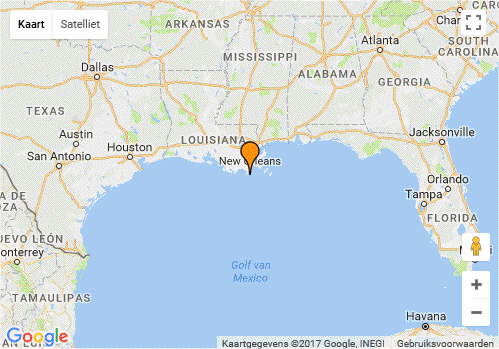
Complement: 40 (25 dead and 15 survivors).
Convoy: -
Route: Baytown, Texas (8 Jul) - Tampa, Florida
Cargo: 70578 barrels of aviation gas and lubricating oil
History: -
Notes on loss:
At 06.19 hours on 10 Jul, 1942, the Benjamin Brewster (Master Peter George J. Hammel) was hit by two torpedoes
from U-67 on the port side about ten seconds apart, while lying at anchor for the night off the coast of Louisiana 60 miles west of South-
west Pass close into shore in about six fathoms of water. One struck at the bridge and the other aft, causing the tanker to immediately
burst into flames from bridge forward. Burning oil and gasoline covered the surface of the water for some distance around the vessel.
Because the wind kept the flames forward some of the eight officers, 27 men and five armed guards (the ship was armed with one 5in
and two .30cal guns) were able to leave the ship from the stern with one partially burned lifeboat as the tanker rapidly sank within three
minutes. Six officers, 18 crewmen and one armed guard died, most of them from burns. Three hours later eight crewmen and three armed
guards in the lifeboat made landfall at Grand Isle, Louisiana. A fishing boat spotted their campfire, picked them up and transferred them
to a Coast Guard vessel, which took them to Burrwood, Louisiana and thence to the Marine Hospital at New Orleans. Three crewmen
and one armed guard were picked up by a Coast Guard vessel and also taken to Burrwood.
The Benjamin Brewster laid in 37 feet of water and burned for nine days until the cargo was consumed. The structure above the water
was reduced to a molten mass of metal by the intense heat and the tanker was a total loss. The wreck was salved in September
1951 and was broken up.
